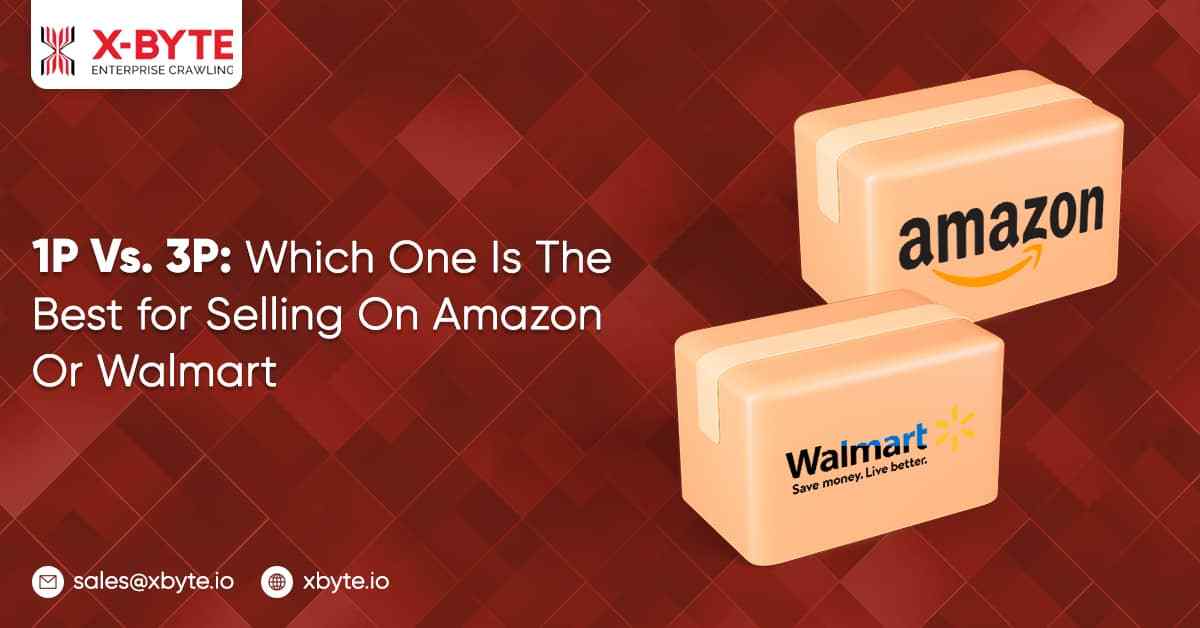
When it comes to selling on Amazon and Walmart, there needs to be more clarity about the best to sell. If you are a seller of these platforms, this confusion must have come to your mind. Worry not, as you are at the right place.
This blog will help you decide which party to choose for selling on Amazon and Walmart. So, let’s begin.
What Is 1P – First-Party Selling

1P refers to a first-party relationship with a retailer. With this selling model, you act as a wholesale supplier for the retailer, who will then sell your products to their end customers and take care of every aspect of fulfillment.
The most common example of first-party selling is Amazon, where they invite you to sell the product as a wholesaler. In this model, you place complete control of your product on Amazon. The platform controls the listings, sets the price accordingly, and decides whether to make another purchase or when.
What Is 3P – Third-Party Selling

3P stands for a third-party relationship with Amazon and Walmart. The third-party seller is someone who sells the product directly to the consumers. This pricing model gives them more control over their product while selling on Amazon.
For example, you have control over your products’ advertising, marketing, and other logistics, including shipping. However, you still have Amazon’s fulfillment by Amazon shipping program to send your product to customers.
How To Sell On Amazon And Walmart?

Amazon and Walmart are the two largest e-commerce sites worldwide, with nearly all of their products sold online. They are also both extremely competitive, which means that you need to be able to stand out from the crowd if you want to sell on them.
The first step is to make your product look appealing. If your product looks good, people will buy it. So make sure your listing has images of the product and its packaging and a description that tells potential buyers what they will be getting for their money.
Include any necessary information about returns, refunds, and other policies related to selling on Amazon or Walmart.
Moreover, you can scrap product data of walmart scraper using a Walmart scraper and Amazon data using a relevant scraper to scrape the data about 1P and 3P of your rivals. Thus, you can set your price scraping strategies accordingly to stay ahead in the competition.
Pros And Cons of Selling On Amazon & Walmart As 1P Vs. 3P

Pros Of 1P
There are many benefits of selling your goods through Amazon and Walmart that you should consider before deciding on which platform to sell your products.
1. Low cost of sales
The most significant benefit of selling through Amazon is the low cost of sales. You can get up to 70% discount on your products by using Amazon FBA service and earn extra revenue from advertising on their website.
2. Easy to Sell
As far as the ease of selling goes, it is effortless to sell your products through Amazon and Walmart because they both have a large customer base worldwide, which makes it easier for you to reach out to them.
3. High Conversion Rate
Another benefit of selling through Amazon is the high conversion rate compared to other platforms like eBay or Shopify. This is because they have an excellent customer service team who will help you promote your products worldwide at no additional cost!
4. Zero Commission Fee
These platforms charge a small fee for listing items on their websites or stores, but they do not charge any commission fees when they sell your items at the end of the transaction or during the checkout process.
Cons Of 1P
Selling through Amazon and Walmart is a great way to make money, but it has a few drawbacks.
1. Less Control Of Your Product
The biggest drawback is that you must sell your product directly to the consumer. You are selling to Amazon or Walmart, which means they have to handle logistics, fulfillment, customer service, and returns.
That means you will spend more time marketing than you would if you sold directly to customers. However, resolving the problem can take longer than dealing directly with customers if there is an issue with your product or service.
2. Higher Risk
Another drawback is that you must rely on two large companies that could go out of business at any moment. If they are bought by another company or suffer a financial crisis, your business could get shut down overnight — even if it has been doing well for years beforehand!
3. Low Margin
Even if you get into the top 10% as a seller, it is still hard work because there are so many other people selling similar products at lower prices that undercut yours by hundreds or even thousands of dollars per item sold.
4. Have No Control Over Inventory
One of the most significant drawbacks of selling through Amazon and Walmart is that you will need more control over your inventory. You need to find out how many items you have in stock, how much they are selling for on a per-unit basis, or how long it will take to sell them all.
Advantages of 3P
1. Higher Margin
The average profit margin for sellers on Amazon is about 50%, compared to about 20% for sellers on eBay. On top of this, you get access to additional services such as shipping and returns management, which allows you to make more money from your business without investing a lot of time.
2. No Middleman Involved
You do not need to pay any fees or commissions because the company will handle all the payments related to the sale of your product.
This means you can avoid dealing with third-party payment processors or financial institutions who charge high fees for processing payments via credit or debit cards.
3. No Extra Charges
There are no listing fees if you use the Amazon or Walmart marketplace! This means that there will be no additional costs associated with selling through these websites like there would be if you were selling on another website like eBay or Etsy.
4. Complete Control Over Your Inventory
If you are selling on the Amazon Marketplace or Walmart Marketplace, you have control of your inventory and can set your price. You also have access to a larger market than other eCommerce platforms, so reaching customers looking for specific items is more effortless.
Drawbacks of 3P
1. You Will Be Responsible for Everything
The biggest drawback of selling on Amazon is that you will be responsible for everything.
You have to deal with customers, shipping, returns and refunds, and all the other things involved in e-commerce. You are also responsible for managing your inventory, keeping track of sales and shipping costs, etc.
2. Responsible For Creating A Purchase Order And Inventory Logistics
The biggest drawback of third-party selling on Amazon is that you are responsible for creating a purchase order and inventory logistics.
You must pay close attention to your inventory and ensure it gets delivered on time. If you are not careful, you could end up with many wasted products and customers who do not receive what they paid.
Amazon Web Scraping takes care of the rest, including packaging, shipping, customer service, and returns. As the largest online retailer in the world, Amazon has the resources to handle most issues efficiently.
3. Subject to More Amazon Marketplace Fees
Another drawback of selling products on Amazon is that you have to pay commission fees to Amazon, which can be as high as 30% of your sales.
This means that if you make $100 in commissions on a product, you will still only make about $30 net profit (assuming you don’t pay any other fees).
Which One Is The Best for Doing Business On Amazon Or Walmart?

Now we know the pros and cons of both parties, and they are equal in their place. So, the question arises which is the best for doing business? Selling on Amazon and Walmart is a great way to increase your profit margins, but there are vital factors to consider before you begin selling on these sites.
Amazon and Walmart have different requirements for their vendors, which can impact your listing. For example, both sites have minimum order quantities, but Amazon has more stringent rules (and higher fees) around those requirements. Other things to consider include the following:
How much stock do you need? Each eCommerce platform has its minimums. At the time of release, Walmart requires a minimum of $10,000 in inventory and $2,500 in product SKUs (stock-keeping units), while Amazon requires only $1,000 in inventory and $1,000 in SKUs.
What kind of products are you selling? Suppose you’re going after large brands or high-end products that fall outside what Walmart sells (like tools or electronics). In that case, it may be worth considering other platforms, such as Amazon Business or eBay Motors (see below).
How competitive are those categories? The price points for many items sold through eCommerce platforms are similar—if not identical—to listings on eBay and Amazon.com. For example, a pair of Nike Air Max shoes on Nike’s online store costs $160, while an identical pair of the same model is available on Amazon for $150.
Several factors influence the cost of a product:
- Shipping fees
- Tax
- The cost of
- materials and
- manufacturing
- The cost of labor
- Retail mark-up
These factors are expressed in terms of percentages of the total retail price. The higher the percentage mark-up, the more expensive the item is to make and sell.
Final Word
The conclusion is that 1P vs. 3P is a crucial decision to make. One of them will help you sell more products and make more money in the long run.
If you are a new seller, it’s better to use 1P because it’s easier to start with, and you can attract more customers immediately.
However, if you already have experience selling on Amazon or Walmart, 3P is the best option because it helps you increase your sales tremendously.
